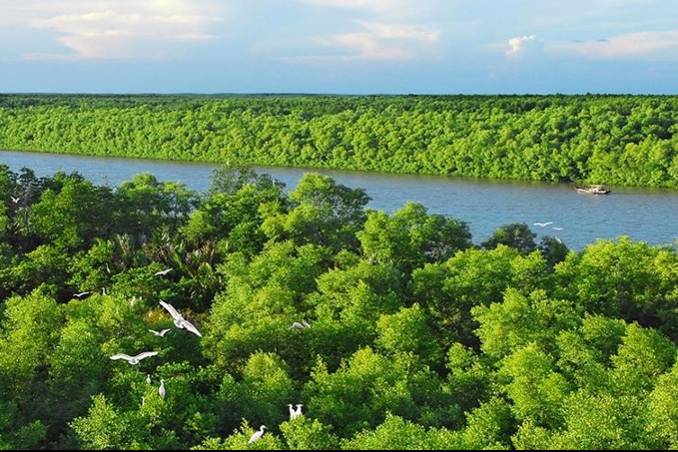According to climate change experts from the United Nations Development Programme (UNDP), the regeneration of mangrove forests could be a solution to simultaneously achieve both greenhouse gas emission reduction and climate change adaptation.
Carbon Storage and Absorption
Nguyễn Đình Thọ, Director of the Institute of Strategy and Policy on Natural Resources and Environment (Ministry of Natural Resources and Environment), noted that evaluating the carbon absorption and storage capacity of mangrove forests will serve as a scientific basis for state management in greenhouse gas emission reduction, mangrove conservation, and development. This assessment also provides valuable information for international negotiations in programs to reduce greenhouse gases. Revenue from carbon sales can support forest management, protection, and development and improve the livelihoods of communities in mangrove forest areas.
Recent research titled "Valuation of the Mangrove Ecosystem in Cà Mau" revealed that the mangrove ecosystem in Cà Mau significantly contributes both directly (through the provision of food, wood, fuel, and tourism) and indirectly (regulation services, carbon storage and absorption, landscape beauty) as well as in terms of conservation value. This study was conducted by the Institute of Strategy and Policy on Natural Resources and Environment in collaboration with Dragon Capital Vietnam Investment Fund Management Joint Stock Company.
With support from the 'From Commitment to Action' project in the Asia-Pacific region, a collaborative initiative between UNDP and various regional partners, UNDP has collaborated with the Forestry Department (Ministry of Agriculture and Rural Development) to develop methods for measuring and calculating the carbon content of mangrove forests. Pilot calculations were carried out for mangrove forests in Hải Phòng, Quảng Ninh, Thừa Thiên-Huế, Bình Định, Ho Chi Minh City, and Cà Mau. Results show that Vietnam's mangrove forests store approximately 245 tons of carbon per hectare, with 29% of this carbon stored in the biomass of living vegetation (including aboveground and belowground roots), while the remaining 71% is stored in soil beneath the mangrove canopy (down to a depth of 30cm).
 Mangroves are carbon sinks and absorbers. Illustration photo
Mangroves are carbon sinks and absorbers. Illustration photo
Enhancing the Effectiveness of Mangroves
To protect and promote the value of mangroves, in October 2021, the Prime Minister approved the Project on Coastal Forest Protection and Development to respond to climate change and promote green growth for the 2021–2030 period. The project aims to sustainably manage, protect, and utilize existing coastal forests and new forested areas during this period. By 2030, the goal is to plant 20,000 hectares of new forests and restore and enrich 15,000 hectares of mangroves.
Efforts to protect, enhance, and realize the economic value of coastal mangroves in Vietnam have been positively received by local communities, businesses, and international organizations. In six coastal provinces—Nam Định, Thanh Hóa, Thừa Thiên-Huế, Quảng Nam, Quảng Ngãi, and Cà Mau—4,260 hectares of mangroves have been supplemented, restored, and newly planted. This is a result of the Mangrove Regeneration Component, a key part of the project 'Enhancing the Resilience of Coastal Communities to the Impacts of Climate Change in Vietnam' (GCF project), co-implemented by the Green Climate Fund, UNDP, and the Vietnamese Government. The Mangrove Regeneration Component focuses on restoring degraded mangrove areas and creating new mangrove forests to enhance coastal resilience and reduce carbon emissions.
Launched in 2018, many of the project's forests have now matured, grown well, and are serving as 'green walls' that protect against waves, secure sea dikes, improve livelihoods, and enhance biodiversity. These 'green walls' are dense plantings of trees or shrubs that act as a barrier against strong winds and waves, thereby protecting the coastline. As of June 2024, the project's mangroves have reduced emissions by more than 1.1 million tons of CO2 (the project's target was over 565,000 tons). The measurement and calculation methods developed and applied by the project serve as an important basis for the Forestry Department (Ministry of Agriculture and Rural Development) to finalize a methodology for measuring and calculating the carbon stock of mangrove forests and to create a provisional technical manual for determining the biomass and carbon stock of coastal mangroves.